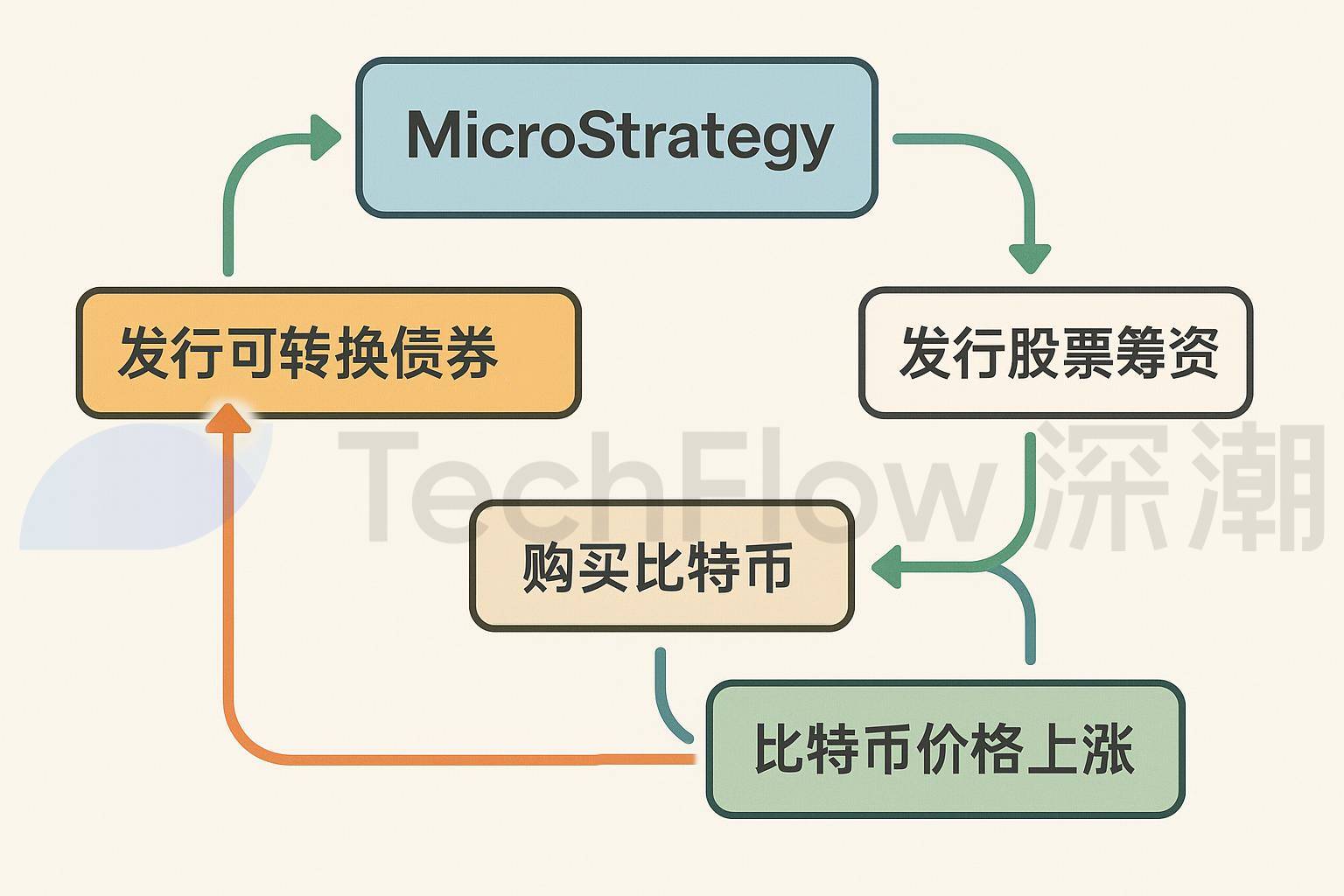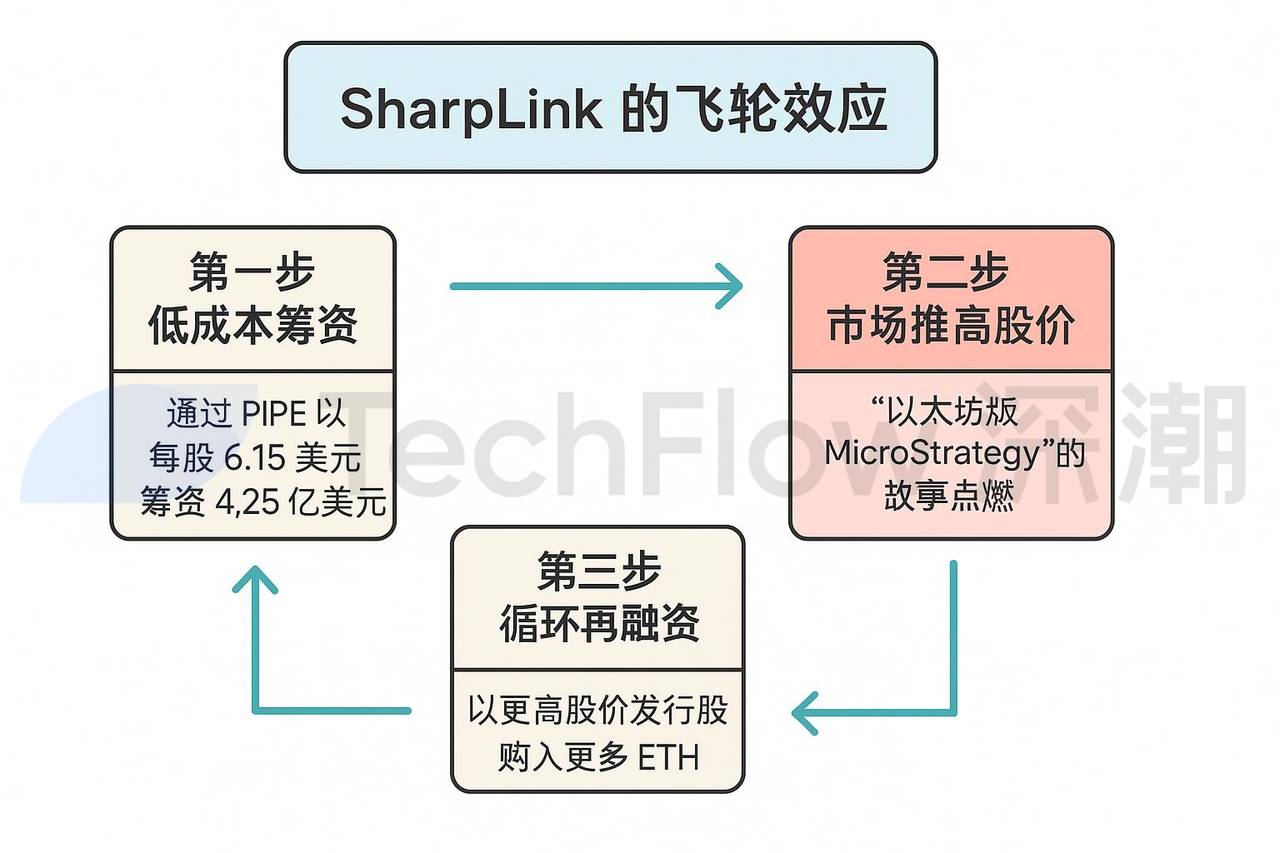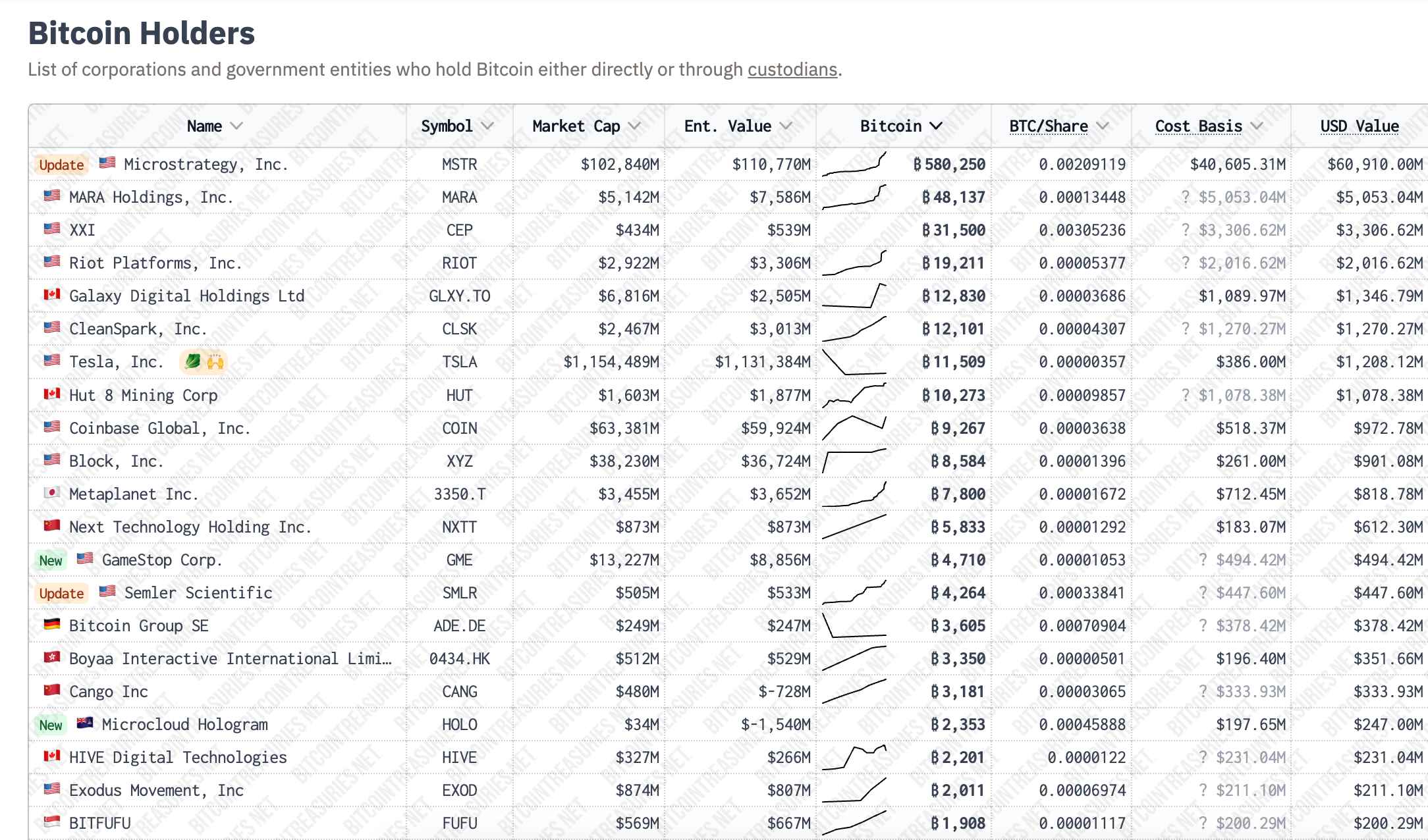The crypto buying strategy has become the new wealth password of U.S. listed companies
Written by: TechFlow
On May 27, on the trading floor of the NASDAQ, a small and obscure stock made a huge wave.
SharpLink Gaming (SBET), a small gaming company with a market cap of just $10 million, announced the purchase of approximately 163,000 Ethereum (ETH) through a $425 million private equity investment.
As soon as the news came out, SharpLink's stock price soared, rising by more than 500% at one point.

Buying currency may be becoming a new wealth code for U.S. listed companies to pull stock prices.
The story naturally begins with MicroStrategy (now renamed Strategy, ticker symbol MSTR), the company that first ignited the flames of war and made a bold bet on Bitcoin back in 2020.
In five years, it has gone from being an ordinary tech company to a "Bitcoin investment pioneer". In 2020, MicroStrategy's stock price was just over $10; By 2025, the stock has soared to $370 and its market capitalisation has surpassed $100 billion.
Buying crypto not only inflated MicroStrategy's balance sheet, but also made it the darling of the capital markets.
In 2025, the craze will intensify.
From tech companies to retail giants to small gaming companies, U.S.-listed companies are using cryptocurrencies to ignite a new engine of valuation.
What is the way to make a large market value wealth password by buying coins?
MicroStrategy, a textbook for the integration of coins and stocks
It all started with MicroStrategy.
In 2020, the enterprise software company spearheaded the U.S. stock buying spree, with CEO Michael Saylor saying that Bitcoin is a "more reliable store of value than the U.S. dollar."
The recharge belief is wonderful, but what really makes this company stand out is its play in the capital market.
MicroStrategy's gameplay can be summed up in a combination of "convertible bonds + Bitcoin":
First, the company raised capital through the issuance of low-interest rate convertible bonds.
Since 2020, MicroStrategy has issued several such bonds with interest rates as low as 0%, well below the market average. For instance, in November 2024, it issued $2.6 billion in convertible bonds with almost zero financing costs.
These bonds allow investors to convert into shares of the company at a fixed price in the future, giving investors a call option while giving the company access to cash at a fraction of the cost.
Second, MicroStrategy puts all of the money raised into Bitcoin. Through multiple rounds of financing, we continue to increase our position in Bitcoin, making Bitcoin a core component of the company's balance sheet.
Finally, MicroStrategy took advantage of the premium effect of Bitcoin's rising price to kick off a "flywheel effect."

When the price of Bitcoin rose from $10,000 in 2020 to $100,000 in 2025, the value of the company's assets increased significantly, attracting more investors to buy the stock. The rise in stock prices has allowed MicroStrategy to reissue bonds or shares at higher valuations to raise more capital and continue to buy Bitcoin, creating a self-reinforcing capital cycle.
At the heart of this model is a combination of low-cost financing and high-return assets. Borrow money at near zero cost through convertible bonds, buy volatile but long-term bullish Bitcoin, and use the market's enthusiasm for crypto to amplify valuations.
This approach has not only changed MicroStrategy's asset structure, but has also provided a textbook model for other U.S. stock companies.
SharpLink, the backdoor is not about wine
SharpLink Gaming (SBET) has optimised the above gameplay by using Ethereum (ETH) instead of Bitcoin.
But behind this, there is also the ingenious combination of the power of the currency circle and the capital market.
Its gameplay can also be summed up by "backdoor", and the core lies in using the "shell" and crypto narrative of listed companies to quickly amplify the valuation bubble.
SharpLink was originally a small company struggling on the verge of delisting on the NASDAQ, with a share price of less than $1 at one point, and less than $2.5 million in shareholders' equity, and huge compliance pressures.
But it has a killer feature - NASDAQ's listing status.
This "shell" has attracted the attention of a giant in the crypto circle: ConsenSys, led by Ethereum co-founder Joe Lubin.
In May 2025, ConsenSys led the acquisition of SharpLink through a $425 million PIPE (private equity financing) in conjunction with a number of crypto VC firms, such as ParaFi Capital and Pantera Capital.
They issued 69.1 million new shares ($6.15 each) and quickly took over 90% control of SharpLink, eliminating the cumbersome process of an IPO or SPAC. Joe Lubin was appointed chair of the board, and ConsenSys made it clear that it would work with SharpLink to explore the "Ethereum vault strategy."
Some say it's an ETH version of micro-strategy, but it's actually more subtle.
The real purpose of this deal is not to improve SharpLink's gaming business, but to serve as a bridgehead for the crypto community to enter the capital market.
ConsenSys plans to use the $425 million to buy about 163,000 ETH, wrap it as an "Ethereum version of MicroStrategy," and claim that ETH is a "digital reserve asset."
Capital markets are a "story premium" narrative that not only attracts speculative money, but also provides a "public ETH proxy" for institutional investors who are unable to hold ETH directly.
Buying crypto is only the first step, and the real "magic" of SharpLink lies in the flywheel effect. Its operation can be broken down into a three-step cycle:

The first step is low-cost financing.
SharpLink raised $425 million through PIPE at $6.15 per share, which is less costly than an IPO or SPAC without the need for a cumbersome roadshow and regulatory process.
In the second step, the market enthusiasm pushes up the stock price.
Investors were ignited by the story of "MicroStrategy on Ethereum", and the stock price soared. The market's enthusiasm for SharpLink stock far outweighs the value of its assets, and investors are willing to pay much more than the net value of their ETH holdings, a "psychological premium" that has allowed SharpLink's market capitalisation to swell rapidly.
SharpLink also plans to stake these ETH tokens, lock them in the Ethereum network, and also earn an annualised yield of 3%-5%.
The third step is revolving refinancing. By re-issuing shares at a higher share price, SharpLink could theoretically raise more money, buy more ETH, and the cycle repeats, snowballing valuations.
Behind this "capital magic", there is a shadow of a bubble.
SharpLink's core business – gaming marketing – is virtually unattended, and the $425 million ETH investment plan is completely out of touch with its fundamentals. Its share price has skyrocketed, driven more by speculative money and crypto narratives.
The truth is that the capital of the currency circle can also use the shells of some small and medium-sized listed companies to quickly blow up the valuation bubble through the model of "backdoor + currency buying".
The drunkard's intention is not to drink, it is naturally good that the business of the listed company itself is related, and it is not important if it is not related.
Imitation is not a one-size-fits-all approach
The crypto buying strategy seems to be the "wealth code" of U.S. listed companies, but it is not a panacea.
The road of imitation was crowded with latecomers.
On May 28, GameStop, the gaming retail giant once known for its retail huddle against Wall Street, announced that it had bought 4,710 bitcoins for $512.6 million in an attempt to replicate MicroStrategy's success. But the market reaction was lukewarm: GameStop shares fell 10.9% after the announcement, and investors didn't buy it.
On May 15, Addentax Group Corp (ticker symbol ATXG, Chinese known as Yingxi Group), a Chinese textile and apparel company, announced plans to purchase 8,000 bitcoins and Trump's TRUMP coin through the issuance of common shares. Even at the current Bitcoin price of $108,000, the purchase would cost more than $800 million.
But by comparison, the company's total market capitalisation is only about $4.5 million, which means that its theoretical cost of acquiring coins is more than 100 times the company's market capitalisation.
Almost at the same time, another Chinese U.S.-listed company, Jiuzi Holdings (stock code JZXN, Chinese name Jiuzi Holdings), also joined the buying frenzy.
The company announced plans to buy 1,000 bitcoins in the next year, at a cost of more than $100 million.
According to public information, Jiuzi Holdings is a Chinese company focusing on the retail of new energy vehicles, which was established in 2019. The Company's retail stores are mainly located in third- and fourth-tier cities in China.
The total market capitalisation of this company's stock on the NASDAQ is only about $50 million.

The stock price is indeed rising, but the match between the company's market capitalisation and the cost of buying the currency is key.
For many latecomers, if the price of bitcoin falls, if it does buy, then its balance sheet will be under great pressure.
The crypto buying strategy is not a universal wealth password. Overleveraged coin buying stakes that lack fundamental support may just be an adventure to the bursting of the bubble.
Another out of the circle
Despite the risks, there is still the potential for a buying spree to become the new normal.
In 2025, global inflationary pressures and expectations of a weaker dollar will continue, and more and more companies will begin to view Bitcoin and Ethereum as "inflation-resistant assets". Japan's Metaplanet has increased its market capitalisation through the Bitcoin Treasury Strategy, and more U.S.-listed companies are moving faster and faster to follow suit.

Under the general trend, cryptocurrencies are increasingly making their way in the global political and economic sphere.
Is this a kind of "out of the circle" that people in the currency circle often talk about?
Looking at the current trends, there are two main paths for cryptocurrencies to go mainstream: the rise of stablecoins and the crypto reserves on the company's balance sheet.
On the surface, stablecoins provide a stable medium for payments, savings, and remittances in the crypto market, reducing volatility and driving the widespread adoption of cryptocurrencies. But its essence is an extension of the hegemony of the dollar.
Taking USDC as an example, its issuer Circle has a close relationship with the U.S. government and holds a large number of U.S. bonds as reserve assets, which not only strengthens the dollar's status as a global reserve currency, but also further penetrates the influence of the U.S. financial system into the global crypto market through the circulation of stablecoins.
Another way out of the circle is to buy coins by listed companies mentioned above.
Crypto buying companies use crypto narratives to attract speculative funds and push up stock prices, but except for a few leading companies, it is still a mystery how much the fundamentals of the main business can be improved by later imitators, in addition to expanding market valuations.
Whether it's stablecoins or crypto assets on the balance sheets of listed companies, crypto assets look more like a tool to perpetuate or strengthen the previous financial landscape.
Whether it's leek or financial innovation, it's more like looking at two sides of the same coin, depending on which end of the table you sit on.
